

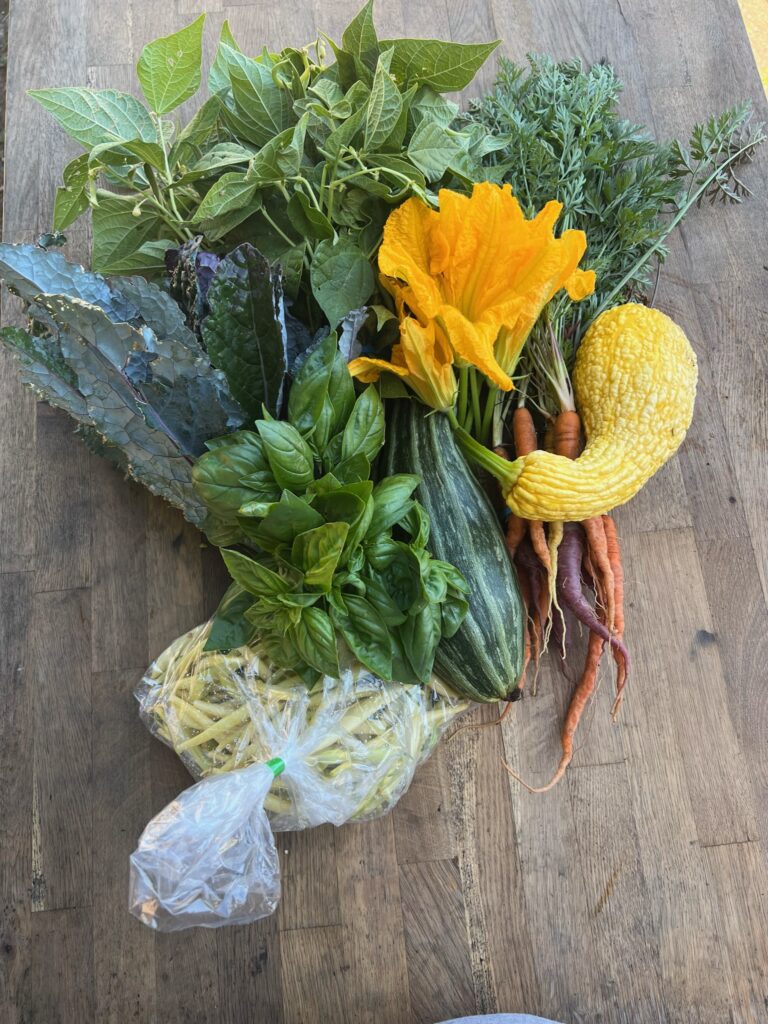
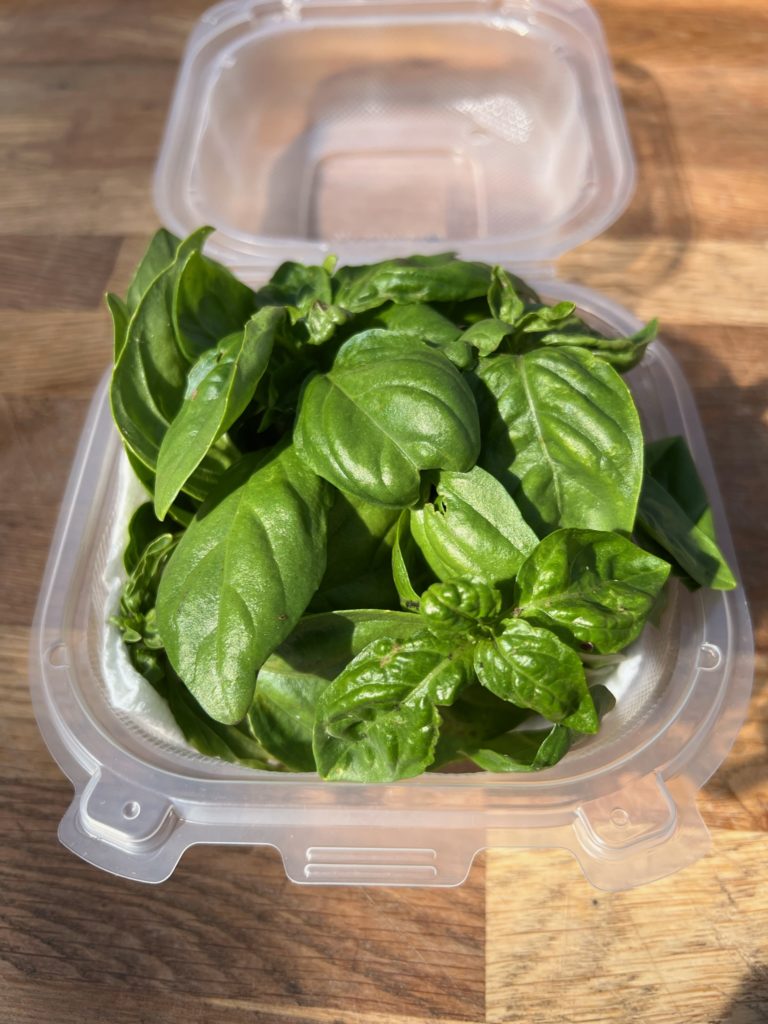
Basil is a highly aromatic herb with a distinct and vibrant flavor. Its leaves are glossy and bright green or purple, and they have a slightly sweet and peppery taste with hints of mint and cloves. Basil is known for its strong fragrance, which is both herbaceous and slightly floral. The scent of basil is often associated with Mediterranean and Italian cuisine, where it is widely used.
In a glass of water: Trim the stems and any leaves that would be under water. Use them first. Place the basil in a glass of water, just like you would with flowers. Store the glass in the refrigerator for up to a week or keep near a window. If you leave it out, you can use the leaves and roots will grow. Change the water every few days. Soon you can plant in a pot and have your own basil plant!
Refrigerator: place basil in a plastic bag with a paper towel or cloth to maintain moisture while allowing airflow.
Rinse. Remove leaves from stems. Chop or use the whole leaf. Eat raw or cooked.

Carrots are vibrant root vegetables known for their distinct crunchy texture and sweet, earthy flavor. They come in various colors, including orange, purple, yellow, and white. Carrots have a satisfyingly crisp bite and a subtly sweet taste that is enhanced when cooked. Whether enjoyed raw as a snack, grated into salads, roasted to bring out their natural sweetness, or used as a flavorful ingredient in soups, stews, and stir-fries, carrots provide a versatile and nutritious addition to a wide range of dishes.
We love growing every color of carrot! Atomic reds might be our favorite. They are the red carrots. Which color is your favorite?
Keep in the fridge. If you plan on storing them longer than a week, remove the greens and the carrots will stay crisp.
Rinse. The whole carrot is edible, including the leaves and root. Carrots can be enjoyed raw or cooked. If the leaves start to wilt, you can revive them by soaking them in ice water for a few minutes, then pat them dry and use as desired.
Freezing: Peel and slice or chop the carrots into desired sizes. Blanch them by briefly boiling in water and then plunging them into ice water to stop the cooking process. Drain well and place the blanched carrots in freezer-safe bags or containers. Label and date them before placing them in the freezer. Frozen carrots can be used in cooked dishes such as soups, stews, and stir-fries.
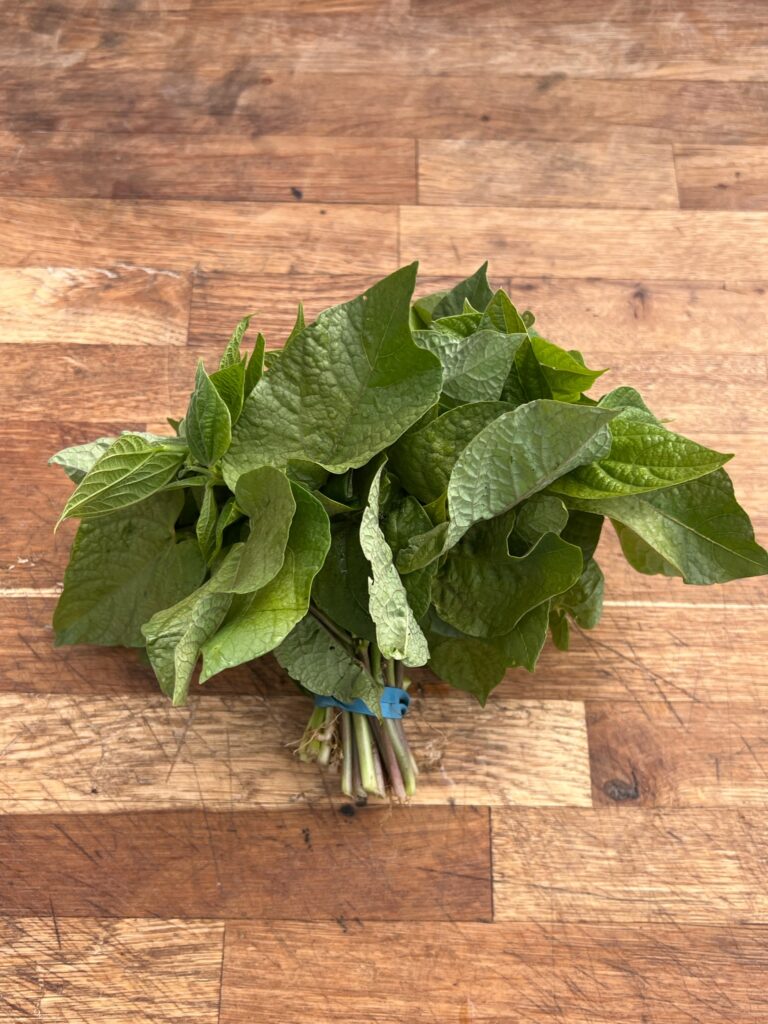
Green bean leaves have a mild and slightly grassy flavor with a hint of nuttiness. The taste is often compared to that of spinach or other leafy greens. The leaves have a tender texture, especially when young, and they can be slightly chewy when cooked. Bean leaves can be consumed raw in salads or used in cooked dishes, such as stir-fries, soups, or stews. They absorb flavors well from other ingredients and seasonings, making them a versatile addition to various culinary preparations.
Rinse. Remove leaves from stems, chop or add whole leaves. Eat raw or cooked.
It's best to use it within a few days for optimal flavor. To store it, place unwashed leaves in a perforated plastic bag or a container lined with a dry paper towel to absorb excess moisture. Seal the bag or container loosely to allow for some airflow. Store the bag in the refrigerator's crisper drawer, where it will stay fresh for a few days.
Freezing: strip the leaves from the stems, and start by blanching them. Bring a large pot of water to a boil and prepare an ice bath. Submerge the leaves in the boiling water for about 1 minute, then quickly transfer them to the ice bath to cool rapidly. Drain the leaves thoroughly and pat them dry. Arrange the blanched and dried leaves in a single layer on a baking sheet and freeze until firm. Transfer the frozen leaves to airtight freezer bags, removing as much air as possible, and seal. Label the bags with the date and store in the freezer for up to 6 to 8 months. Thaw the frozen leaves in the refrigerator before using them in cooked dishes.
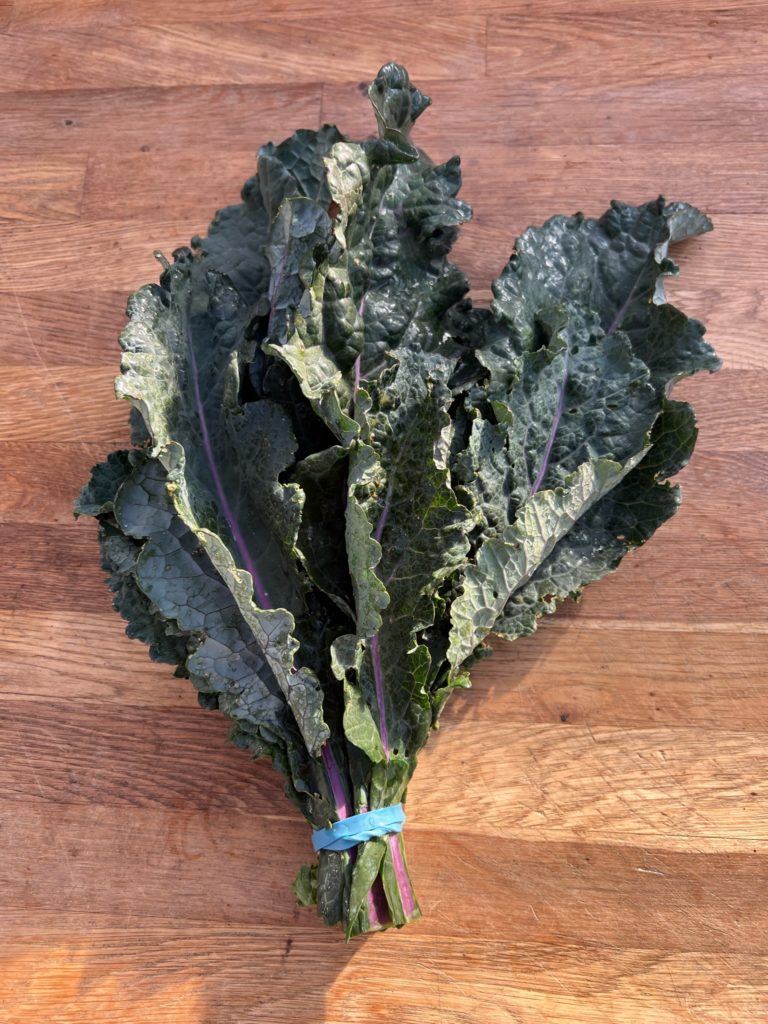
This a mix of Dazzling Blue, Red Russian and Scarlett kale.
Rinse. Eat raw or cooked. Stems take longer to cook. I like to remove them and cook longer than leaves.
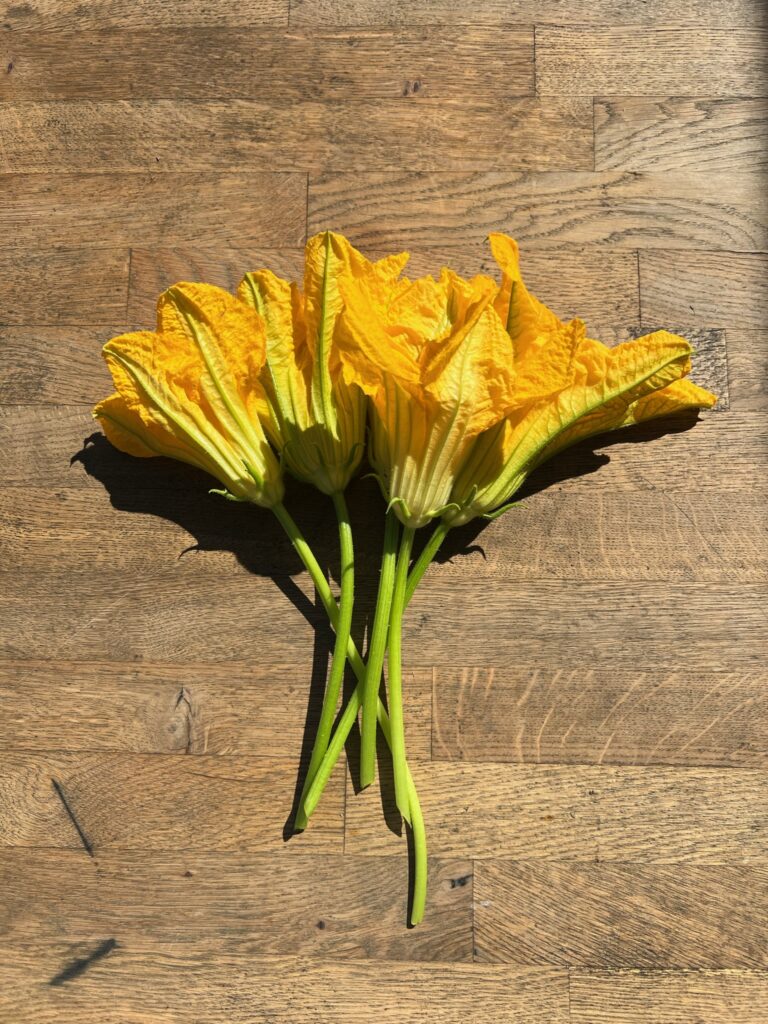
Squash blossoms are delicate and vibrant edible flowers that bloom from various types of squash plants, including zucchini, pumpkin, and other squash varieties. These blossoms have bright yellow to orange petals with a delicate, slightly sweet flavor. While they are visually appealing and often used for decorative purposes, they are also a prized culinary ingredient in many cuisines worldwide. Commonly stuffed with cheese or other fillings and then either deep-fried or sautéed, squash blossoms add a unique and delightful touch to dishes, bringing a taste of the garden to the table.
You received male blossoms.
Gently wrap them in a slightly damp paper towel and place them in a loosely sealed plastic bag or airtight container. Store them in the refrigerator's crisper drawer to help maintain their freshness. It's essential to use them as soon as possible, preferably within a day or two, as they are delicate and can wilt quickly. Avoid washing the blossoms until you're ready to use them, as excess moisture can lead to spoilage. With proper storage, you can preserve the delicate flavor and vibrant appearance of squash blossoms for culinary delights in various dishes.
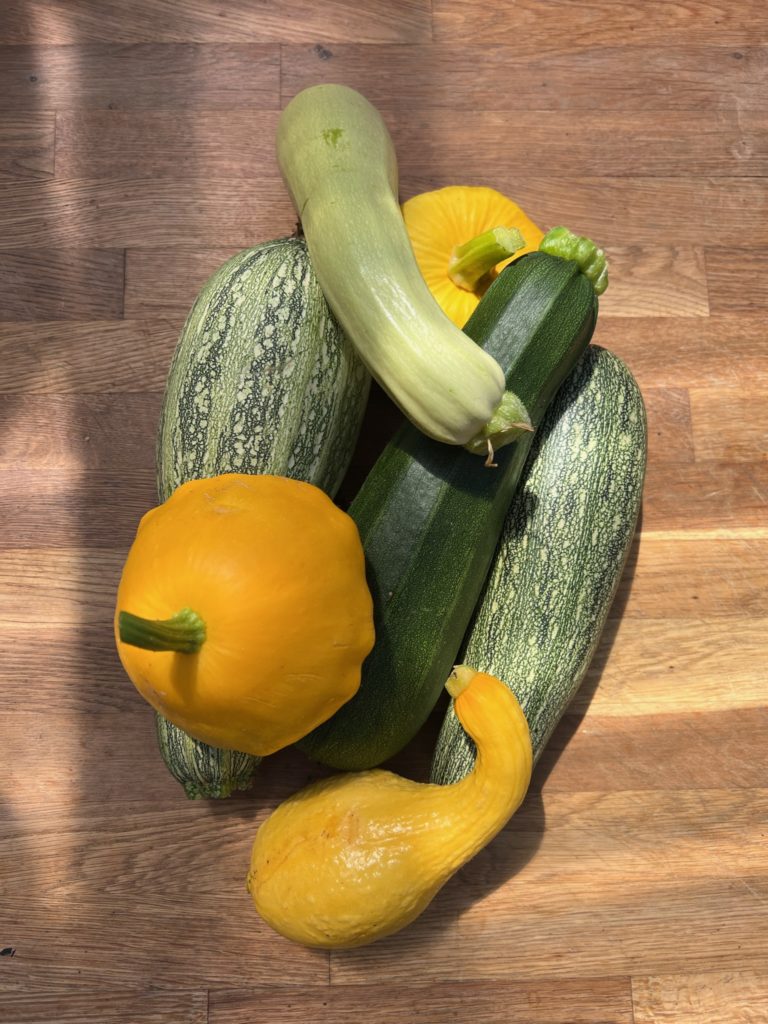
Summer squash refers to a variety of tender, edible gourds that are harvested during the summer months. They typically have a vibrant, yellow or green skin and a mild, slightly sweet flavor. Summer squash comes in various shapes, including elongated, cylindrical zucchini and round or bulbous varieties like pattypan and yellow crookneck squash. The flesh is tender and succulent, with a delicate texture that holds up well in both raw and cooked preparations.
Rinse. Eat raw or cooked.
Handle gently. The skin is thin and fragile. Keep on the counter and use within a week. If you aren't going to use them right away keep in the refrigerator.
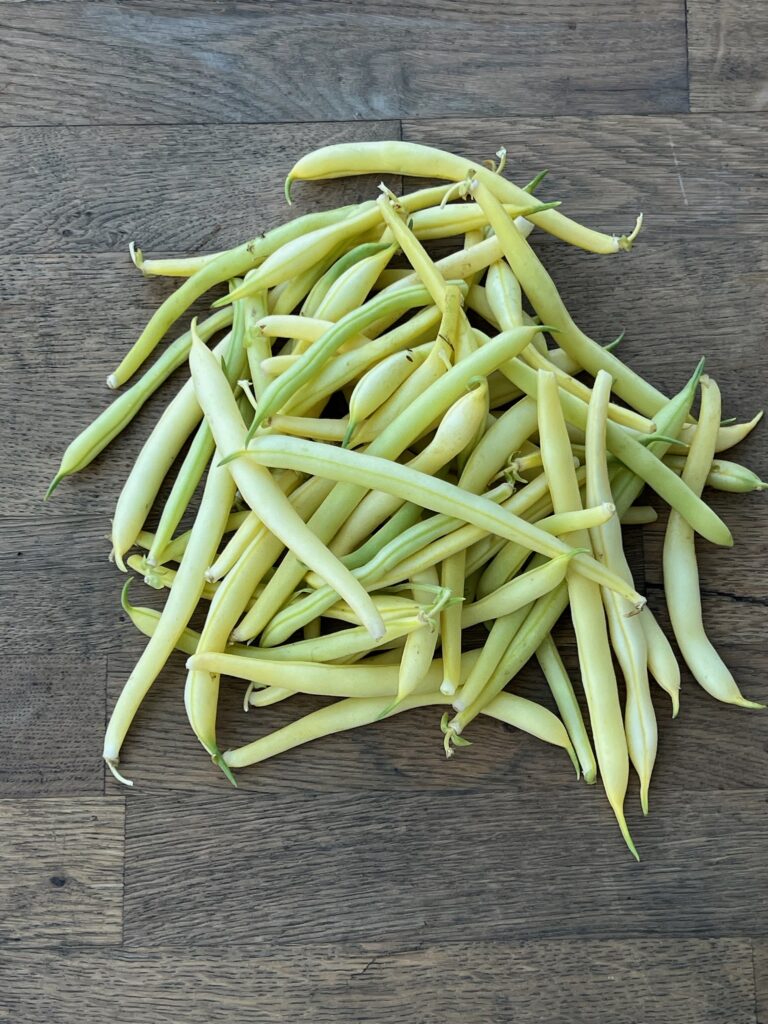
Wax beans, also known as yellow beans or butter beans, are slender, elongated pods that are harvested when young and tender. They have a smooth, waxy texture with a slightly sweeter and milder flavor compared to green beans. Wax beans typically have a bright yellow color, and like their green counterparts, they are widely used in various cuisines across the globe. Whether sautéed, steamed, roasted, or included in salads, stir-fries, or casseroles, wax beans offer a delightful and versatile addition to meals.
Wax beans should be used sooner versus later. Place the unwashed wax beans in a bag or a container lined with a dry paper towel to absorb excess moisture. Leave the bag slightly open or use a container with ventilation to allow for some airflow. Store the wax beans in the refrigerator's crisper drawer, where they will stay fresh for up to a week. It's best to avoid washing the beans until you're ready to use them, as excess moisture can lead to spoilage.
These are stringless beans. That means you only need to remove the stem end to enjoy. Rinse. Eat raw or cooked.
Freezing: Blanch the wax beans by briefly boiling them in water, then transferring them to an ice bath to cool. Drain well and place the blanched beans in freezer-safe bags or containers. Label and date them before placing them in the freezer. Frozen wax beans can be used in various cooked dishes such as soups, stews, and stir-fries.